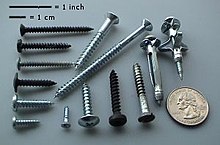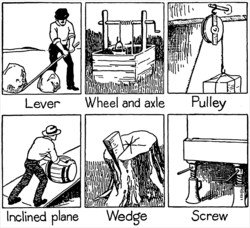Screw
A screw is an externally helical threaded fastener capable of being tightened or released by a twisting force (torque) to the head.The screw head on one end has a milled slot or other feature that commonly requires a tool to transfer the twisting force.[16] The metal screw did not become a common fastener until machine tools for mass production developed toward the end of the 18th century.It made use of a leadscrew to guide the cutter to produce the desired pitch,[19] and the slot was cut with a rotary file while the main spindle held still (presaging live tools on lathes 250 years later).[citation needed] These developments of the 1760–1800 era, with the Wyatts and Maudslay as arguably the most important drivers, caused great increase in the use of threaded fasteners.[23] The American development of the turret lathe (1840s) and of automatic screw machines derived from it (1870s) drastically reduced the unit cost of threaded fasteners by increasingly automating the machine-tool control.[citation needed] Throughout the 19th century, the most commonly used forms of screw head (that is, drive types) were simple internal-wrenching straight slots and external-wrenching squares and hexagons.In 1908, Canadian P. L. Robertson was the first to make the internal-wrenching square socket drive a practical reality by developing just the right design (slight taper angles and overall proportions) to allow the head to be stamped easily but successfully, with the metal cold forming as desired rather than being sheared or displaced in unwanted ways.[citation needed] Precision screws, for controlling motion rather than fastening, developed around the turn of the 19th century, and represented one of the central technical advances, along with flat surfaces, that enabled the industrial revolution.The wire or rod is then cut to the proper length for the type of screw being made; this workpiece is known as a blank.Fasteners with a non-tapered shank are generally designed to mate with a nut or to be driven into a tapped hole, and most would be classed as bolts, although some are thread-forming (eg.Early wood screws were made by hand, with a series of files, chisels, and other cutting tools, and these can be spotted easily by noting the irregular spacing and shape of the threads, as well as file marks remaining on the head of the screw and in the area between threads.[30] Some wood screws were made with cutting dies as early as the late 1700s (possibly even before 1678 when the book content was first published in parts).The majority of modern wood screws, except for those made of brass, are formed on thread rolling machines.ASME standards specify a variety of machine screws (aka stove bolts[citation needed]) [34] in diameters ranging up to 0.75 in (19.05 mm).A machine screw or bolt is usually a smaller fastener (less than 1⁄4 inch (6.35 mm) in diameter) threaded the entire length of its shank that usually has a recessed drive type (slotted, Phillips, etc.ASME standard B18.2.1-1996 specifies hex cap screws whose size range is 0.25–3 in (6.35–76.20 mm) in diameter.As with aerospace and nuclear power, medical use involves some of the highest technology for fasteners; excellent performance, longevity, and quality are required, and reflected in prices.A few varieties of screw are manufactured with a break-away head, which snaps off when adequate torque is applied, to prevent removal after fitting, often to avoid tampering.There are many standards governing the material and mechanical properties of imperial sized externally threaded fasteners.More exotic screw drive types may be used in situations where tampering is undesirable, such as in electronic appliances that should not be serviced by the user.For some diameters, one or two additional fine pitch variants are also specified, for special applications such as threads in thin-walled pipes.Note that while 1/4" UNC bolts fit 1/4" BSW camera tripod bushes, yield strength is reduced by the different thread angles of 60° and 55° respectively.Screws were described as "2BA", "4BA" etc., the odd numbers being rarely used, except in equipment made prior to the 1970s for telephone exchanges in the UK.BA threads are extensively used in Model Engineering where the smaller hex head sizes make scale fastenings easier to represent.[55] The Unified Thread Standard (UTS) is most commonly used in the United States, but is also extensively used in Canada and occasionally in other countries.Note: In countries other than the United States and Canada, the ISO Metric Screw Thread System is primarily used today.[citation needed] It is estimated that approximately 60% of screw threads in use in the United States are still inch based.Such inferior fasteners are a danger to life and property when used in aircraft, automobiles, heavy trucks, and similar critical applications.An externally threaded fastener which is prevented from being turned during assembly and which can be tightened or released only by torquing a nut is a bolt.









b — dome (button)
c — round
d — truss (mushroom)
e — flat (countersunk)
f — oval (raised head)


Screw (disambiguation)US quarterclassical simple machineshelical threadedfastenertwisting forcetorquetorquingmilledscrewdriverswrencheshex keysbearing surfacegrub screwclockwiseleft-hand threadscrew mechanismsimple machinesRenaissanceleadscrewBrown & Sharpespindledowelsmortises and tenonsdovetailsnailingforge weldingMesopotamiaNeo-AssyrianAncient EgyptAncient GreeceGreek mathematician Archytas of TarentumMediterraneanscrew pressesolive oilwinemakingscrewdriverHousebook of Wolfegg Castlemachine toolsmass productionconvergedStaffordshireJesse Ramsdentoolmakingscrew-cutting latheHenry MaudslaycommodificationJames Nasmythunit pricestoolroomPhilipsburgturret lathecost reduction spurred ever greater usedrive typesmachineP. L. Robertsoncold forminghex socketHenry F. PhillipsPhillips-head screwPozidrivSupadrivindustrial revolutionmicrometersThreading (manufacturing)bar stockcold headedcold workingthread rollingtumble finishedelectroplatinggalvanizingblack oxideList of screw and bolt typestaptitefemale threaded fastenerswagingSelf-tapping screwdiametermisnomerstavesgalvanizationhot-dip galvanizedInternal fixationscrew drivebugle.flat washercountersinkingISO 898ASTM A325MRockwellASTM A490M304 stainless steelProof strengthBrinellASTM A325ASTM A354ASTM A49018/8 StainlessHex socket (Allen)External TorxPentalobepower drillsscrew drive designsScrew threadISO metric screw threadBritish Standard WhitworthBA system (British Association)Unified Thread Standardinternational standardISO 68-1ISO 262multiplication signhexagonInternational StandardsEnglishengineerJoseph Whitworththread anglescaffoldingtripodyield strengthBritish Association screw threadsUnited StatesCanada
